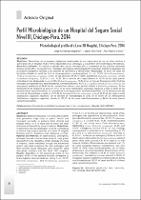Perfil Microbiológico de un Hospital del Seguro Social Nivel III, Chiclayo-Perú. 2014
Related Resource(s)
http://cmhnaaa.org.pe/ojs/index.php/rcmhnaaa/article/view/141Date
2019-02-18Author(s)
Fernández Mogollón, Jorge
Tello Vera, Stalin
Pizarro Chima, Flor
Metadata
Show full item recordAlternate title
Microbiological profile of a Level III Hospital, Chiclayo-Peru. 2014
Abstract
Objetivos: Determinar los principales patógenos involucrados en las infecciones de los servicios clínicos y quirúrgicos de un hospital Nivel III de la seguridad social (Chiclayo) y sus perfiles de Sensibilidad y Resistencia. Material y métodos: Se realizó un estudio descriptivo, retrospectivo y transversal de los cultivos realizados durante el año 2014. Se consideró los resultados del sistema automatizado Vytek durante el 2014. Evaluándose los principales patógenos hallados y sus perfiles de resistencia y sensibilidad. Resultados: El 69,8% de todas las bacterias aisladas en medicina interna correspondieron a gramnegativos, (E. coli, 39,2%; Klebsiella pneumoniae, 17,6% y Pseudomona aeruginosa, 5,1%). En los servicios de UCI y UCIN, predominó Klebsiella neumoniae, 27,3%; Pseudomona aeruginosa, 13,6% y E. coli, 11,5%. En el servicio de cirugía General el 42,9% de los casos fueron enterobacterias, destacando E.coli, 23,8% y Klebsiella neumoniae, 19,0%. En el servicio de Emergencia el 65,3% de los hallazgos correspondieron a enterobacterias, correspondiendo el 41,7% a E.coli y el 23,6% a Klebsiella neumoniae. En emergencia pediátrica el 84,8% de los coprocultivos obtuvo como germen aislado a Klebsiella pneumoniae. En los hemocultivos de Pediatría se aisló en el 61,1% de casos Stafilococos coagulasa negativos y solo el 40,0% de los mismos fueron oxacilinsensibles, la totalidad de estas cepas fueron vancomicinsensibles. En los hemocultivos del servicio de Hematología se aisló en el 29,4% de los casos Klebsiella pneumoniae, y en el 23,5% de los casos se aisló Stafilococos coagulasa negativos. En el servicio de Neonatología se aisló en el 50,0% de los hemocultivos Stafilococos coagulasa negativos, siendo el 100,0% de los casos oxacilinresistentes y 88,6% de estos fueron vancomicinsensibles. Objetives: Bacterial resistance is a worldwide problem
that generates huge costs to public health and
increased mortality in patients both clinical and
surgical areas, so it is important to know the local
resistance and sensitivity in each hospital. Objectives:
To determine the main pathogens involved in infections
of clinical and surgical services of a Level III hospital
Chiclayo and its sensitivity and resistance profiles.
Material and Methods: an observational, Descriptive,
retrospective and cross-sectional study of crops grown
during 2014 in the laboratory of Microbiology of a level
III hospital, Vytek evaluated through the automated
system was made evaluated the main pathogens and
their profiles found resistance and sensitivity using
descriptive statistics and the Excel 2013 program.
Results: Regardless of the anatomical origin of the
sample, 69.8% of the bacteria isolated correspond to
Gram-negative internal medicine, led by E.coli, 39.2%;
Klebsiella pneumoniae, and Pseudomonas aeruginosa
17.6%, 5.1%. In the ICU and NICU services, 52.5% of the
pathogens was represented by enterobacteria, which
prevailed Klebsiella pneumoniae, 27.3%; Pseudomonas
aeruginosa, E. coli and 13.6%, 11.5%. In general surgery
42.9% of the cases were Enterobacteriaceae,
highlighting E.coli, Klebsiella pneumoniae 23.8% and
19.0%. Emergency service 65.3% of the findings
corresponded to enterobacteria, corresponding 41.7%
to 23.6% E.coli and Klebsiella pneumoniae, the first in
62.6% of . In the second emergency Pediatric 84.8% of
stool cultures obtained as Klebsiella pneumoniae isolated
germ; while urine cultures in 81.8% of cases E.coli was
isolated. Pediatric Blood cultures was isolated in 61.1%
of cases coagulase-negative staphylococci and only
40.0% of them were oxacilinsensibles, all of these
strains were vancomicinsensibles. Blood cultures of the
hematology was isolated in 29.4% of cases Klebsiella
pneumoniae. Neonatal service was isolated in 50.0% of
coagulase-negative staphylococci blood cultures, being
oxacilinresistentes 100.0% of cases and 88.6% of these
were vancomicinsensibles.






